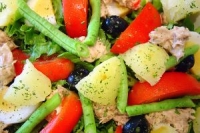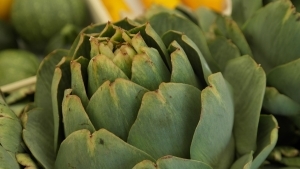Pavarotti's Glazed Ham with Seville Oranges
(Serves 40-50)
This is the very ham I served to Luciano Pavarotti when he visited Auckland in 1999, the one which he pronounced 'magnifico!', and the very one he devoured with such delight after which he hugged me and pleaded for la ricetta (the recipe).

Luciano Pavarotti / Pavarotti's ham Photo: Ramzi Haidar / Supplied
Ingredients
- 3 oranges (use Seville oranges, if available, or tangelos)
- 1 cup runny honey
- 1/4 cup fresh orange juice
- 1 cup brown sugar
- 2 tsp Dijon-style mustard
- 1 cooked free-range NZ ham on the bone
- cloves
- heavy-duty aluminium foil
Method
1. Peel the rind from the orange skin and cut it into short strips. In a small bowl mix the honey, orange juice, brown sugar and mustard.
2. Carefully strip the skin off the ham, trying not to disturb the layer of creamy fat beneath it. Score the surface of the fat into small diamond shapes and stud each diamond with a whole clove.
3. Line a large roasting tin with a double thickness of aluminium foil, raising the foil above the edges of the tin. This will catch drips of glaze falling off the ham and prevent flare-ups in the oven. Place the ham in the tin, making sure the foil stays upright.
4. Pour the glaze over the ham and put the ham in an oven preheated to 225°C. Mix the strips of orange peel in the glaze bowl, coating them with any remaining glaze. Spoon the orange strips over the top of the ham about half way though cooking. If glazing for appearance only, it will take about 45 minutes. As parts of the fat take on enough colour, place small pieces of foil on top to deflect the heat.
If you want to serve the ham hot, allow an hour longer (1 1/2 - 1 3/4 hours in total) to heat through, but lower the heat to 180°C after one hour. You may need to protect the entire surface of the ham with foil after 50-60 minutes. The ham should be basted with the glaze every 15 minutes.
Slicing the ham
There are many methods. I find the following one easiest to remember and it ensures that every slice gets a little fat. If you are right-handed, place the shank of the leg to your left. Slice vertically down through the fat, about two-thirds along the leg from the shank end. Stop when you meet the bone. Slice another cut parallel to the first, but at a slight angle, making a thin wedge-shaped slice which can be levered out. Now slice out thin wedges, first from the right side, then from the left. When you are no longer able to slice like this, turn the ham over and slice the underside, cutting across the grain as much as possible.
Many people prefer to slice right across the meat, lifting off 90% of the fat with the first slice. I don't agree with this method, not only because it robs all but the first few diners of a little fat with the lean, but because, if the ham is to be stored and used again, the fat will keep the meat moist and sweet.


